How to use the Next.js PWA sponsored transactions template
This guide walks you through using the template which uses Next.js, Serwist (offline capabilities), and Privy smart wallet (authentication and transaction sponsorship) to build a Progressive Web Application (PWA) on Monad.
Prerequisites
- Node.js (v18 or higher)
- a Privy account
- a Pimlico account
Setting up Privy
-
Create your Privy app:
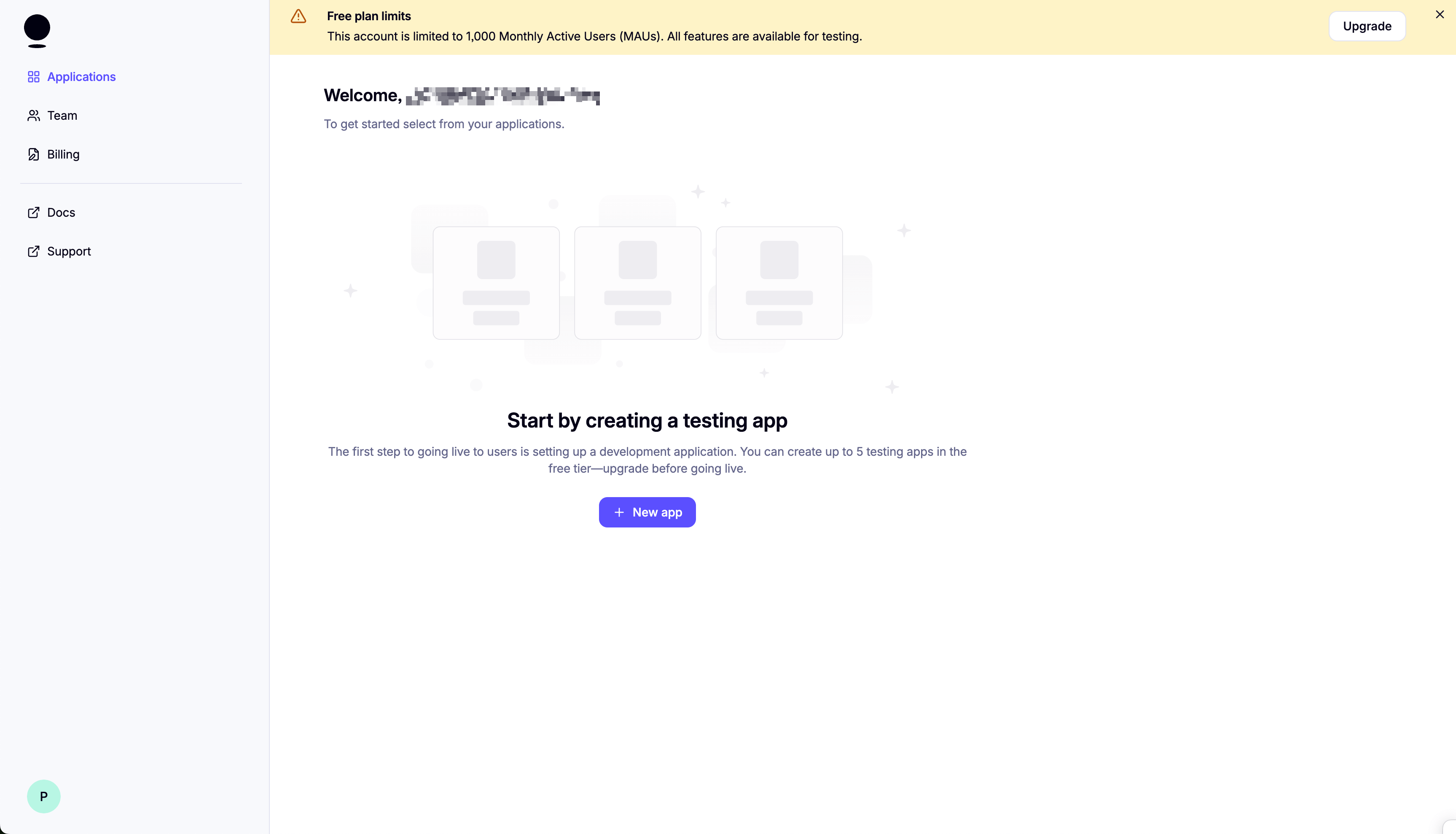
Select "Web" as the platform. Then, click "Create app".
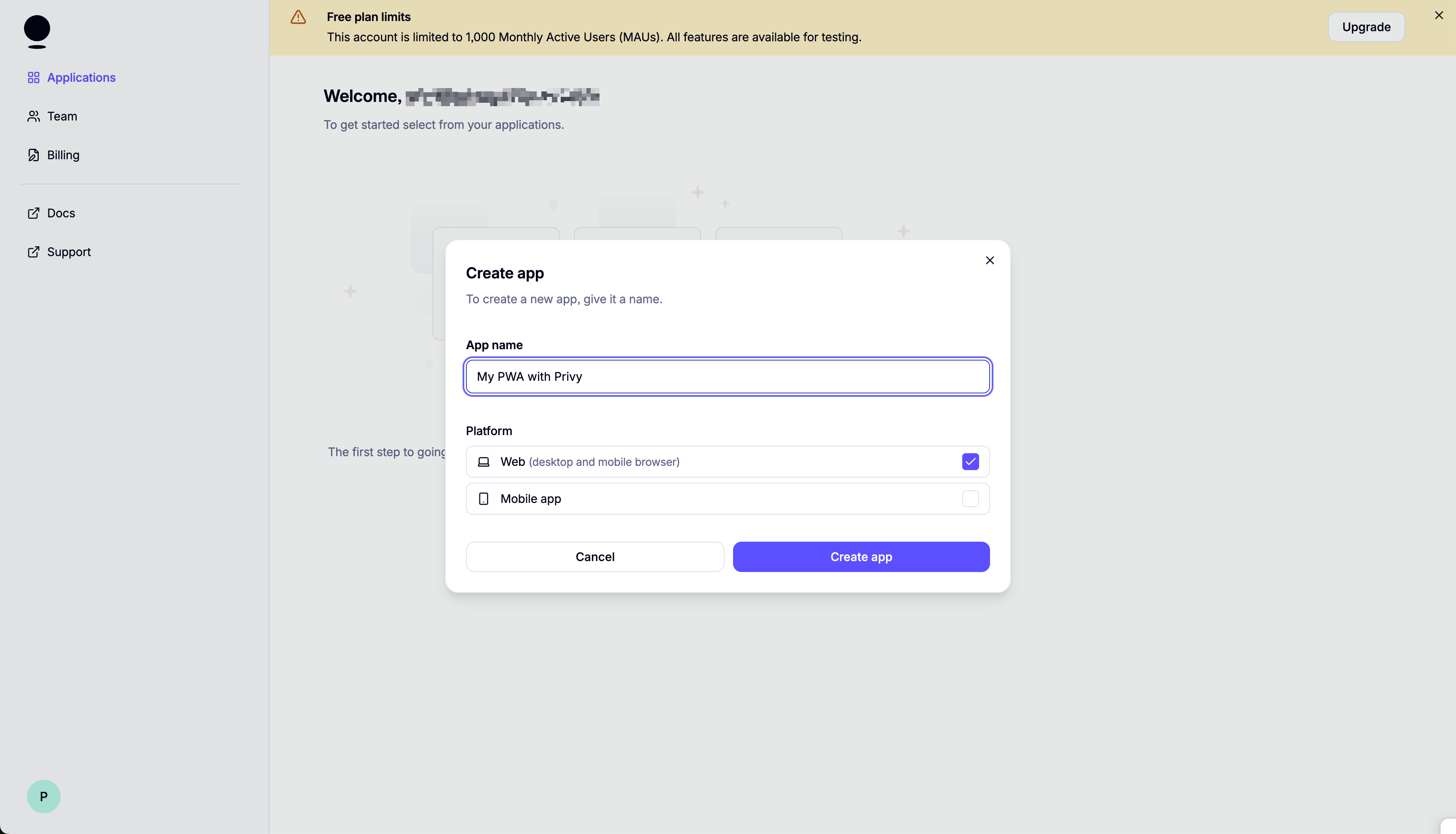
On the next screen, make sure to save your App ID.
-
Set up login methods:
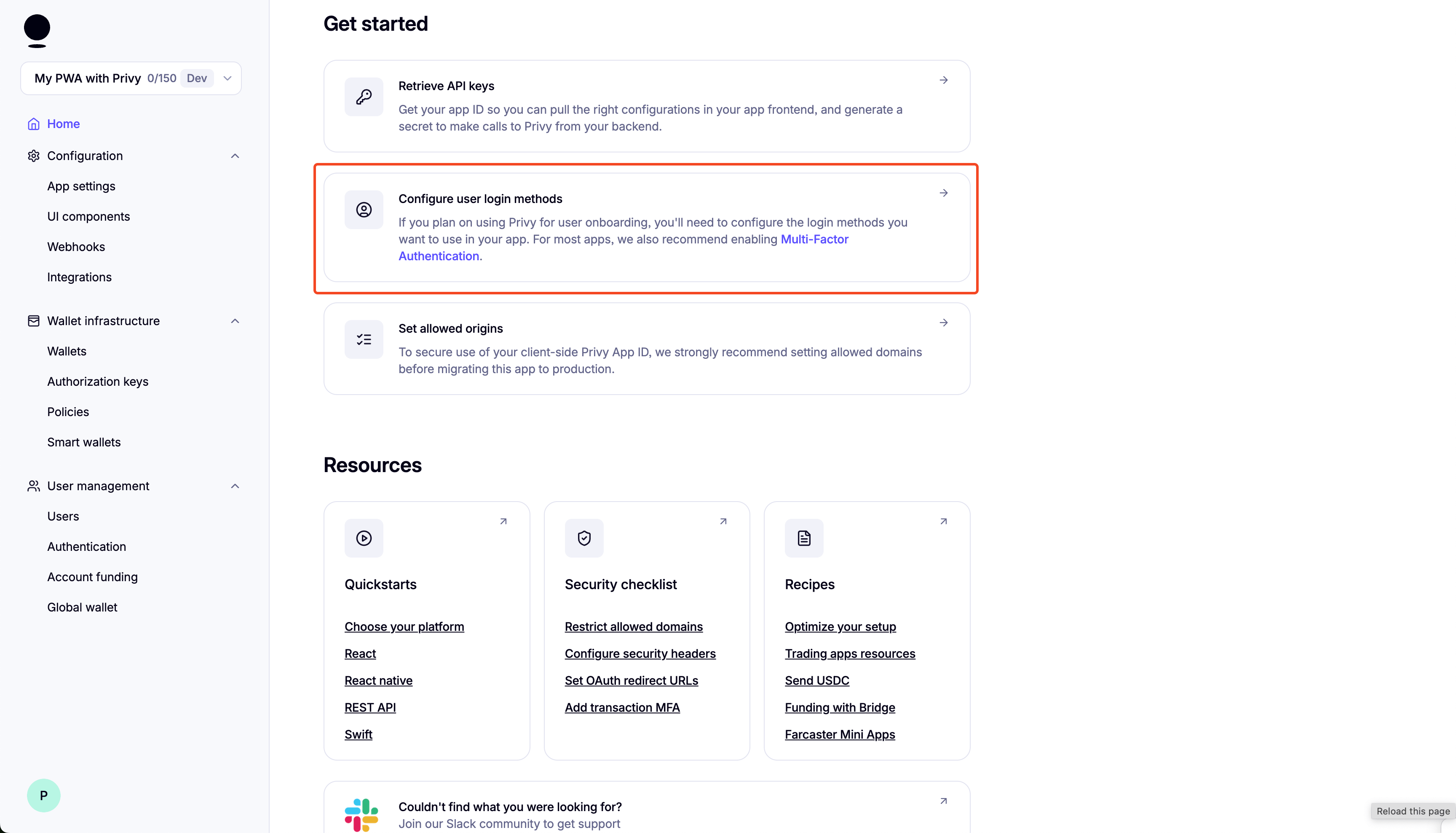
-
Disable External Wallets:
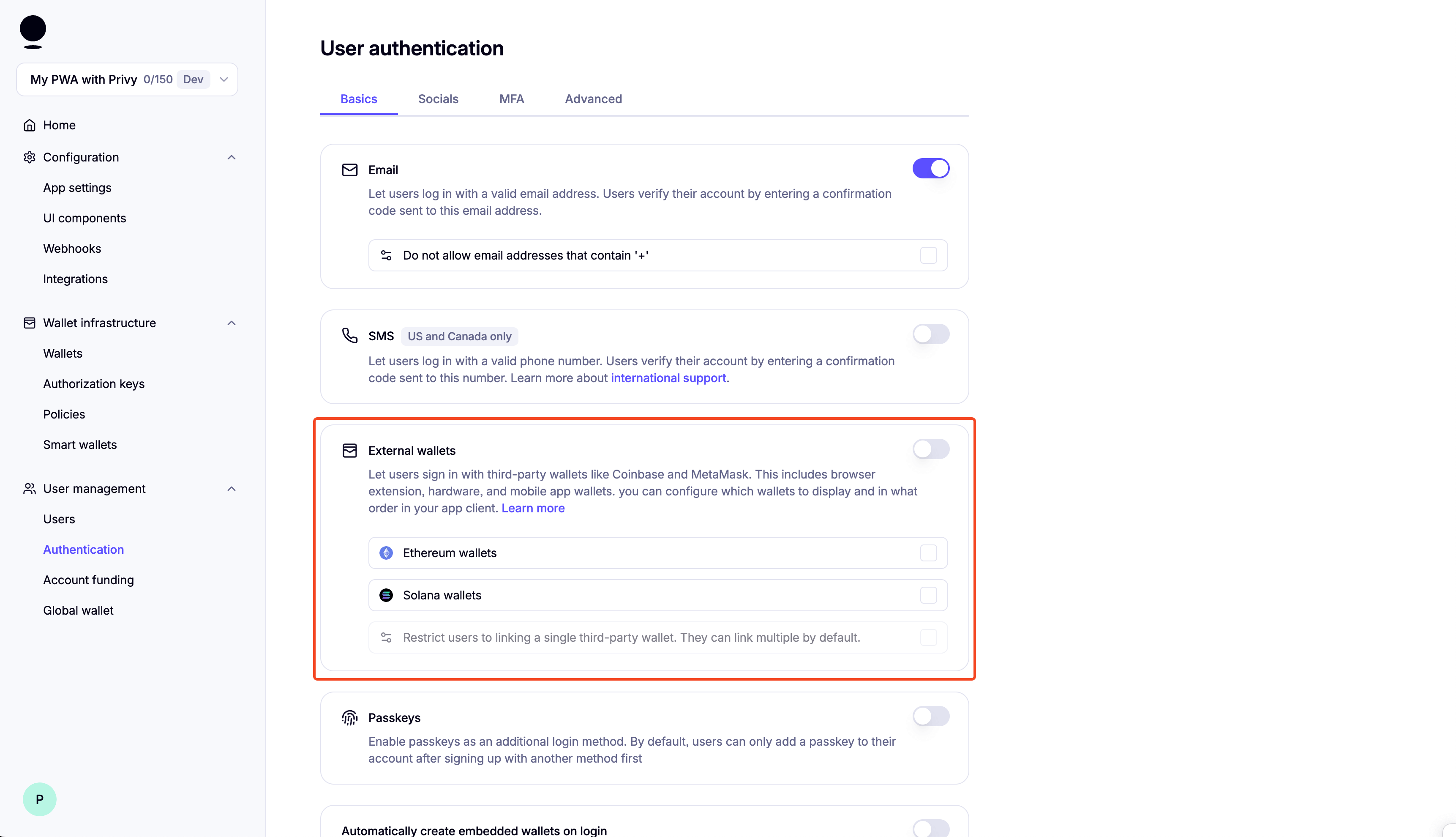
-
Scroll down and enable "Automatically create embedded wallets on login" and select "EVM Wallets":
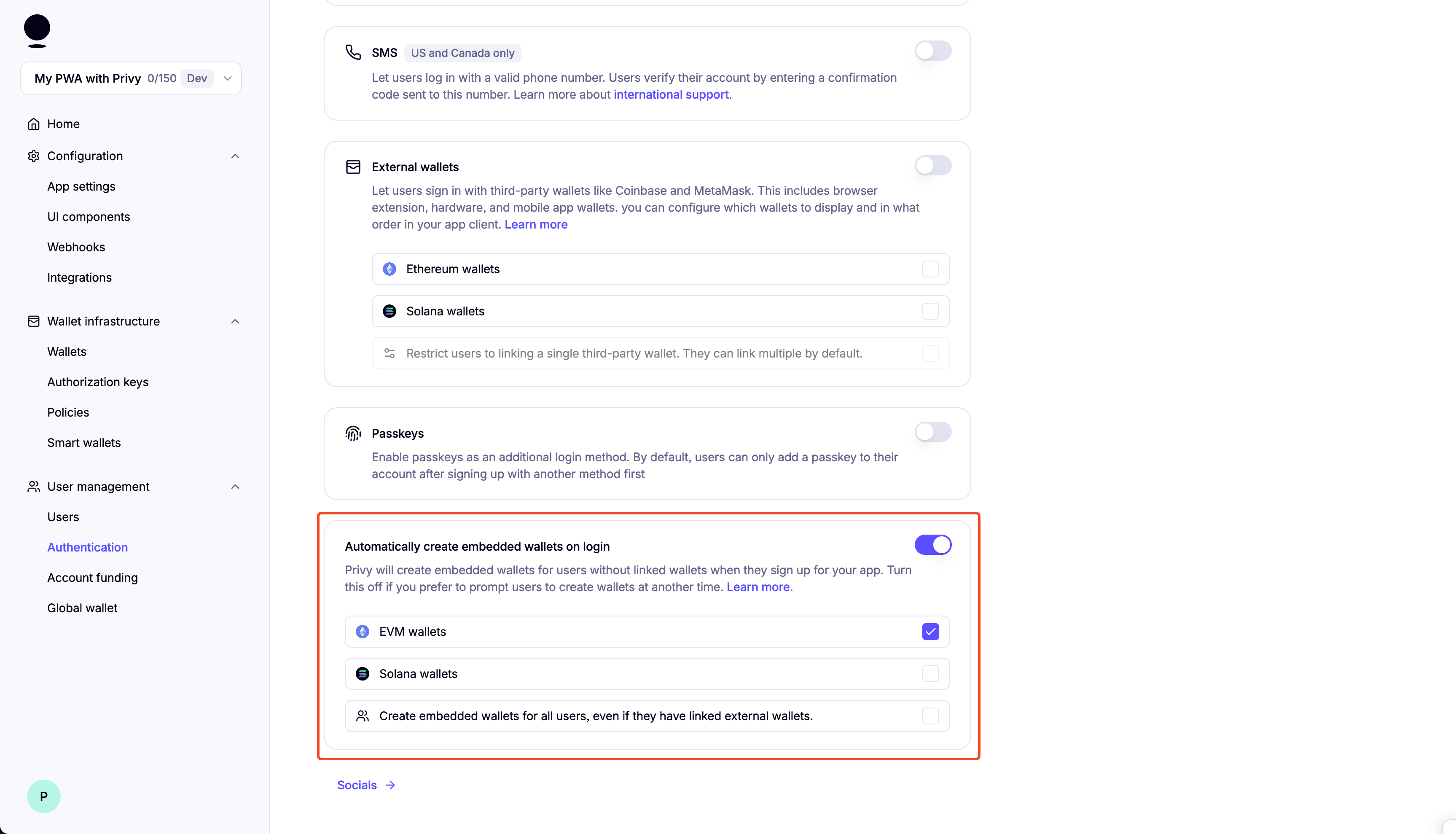
You can enable "Test Accounts" for testing purposes:

Setting up Pimlico
-
Sign up for a Pimlico account and go to "API Keys"
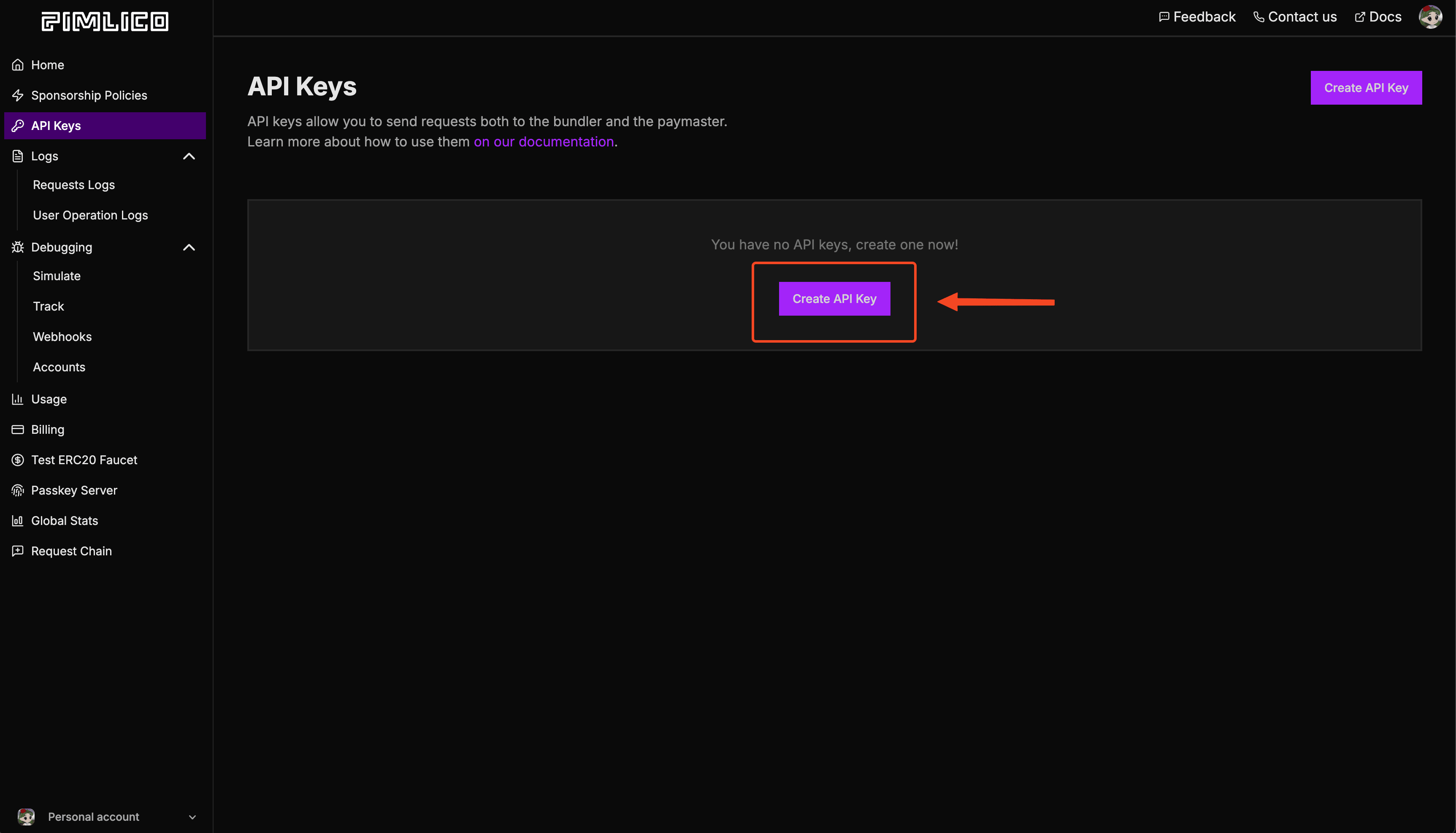
-
Create a new API key:

-
Click on RPC URLs, then Select "Monad Testnet", and copy the RPC URL:
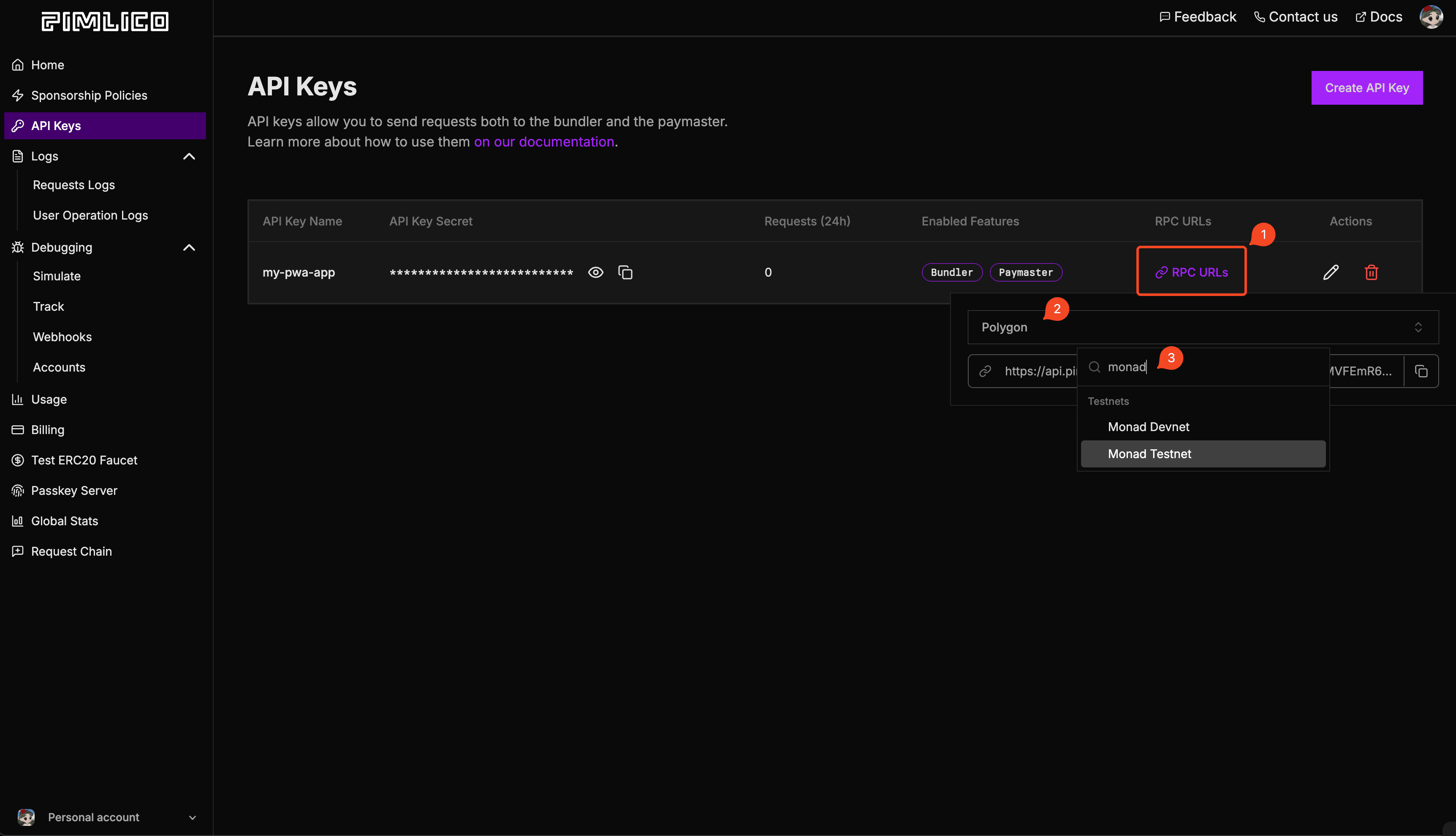
-
Copy the RPC URL and save it to your
.env.localfile asNEXT_PUBLIC_PIMLICO_BUNDLER_URL.
Setup
-
Clone the repository:
git clone https://github.com/monad-developers/next-serwist-privy-smart-wallet.git -
cdinto the project directory:cd next-serwist-privy-smart-wallet -
Install dependencies:
npm install -
Create a
.env.localfile in the root directory:cp .env.example .env.local -
Start adding your environment variables to the
.env.localfile:# PrivyNEXT_PUBLIC_PRIVY_APP_ID=your_privy_app_id_hereNEXT_PUBLIC_PRIVY_CLIENT_ID= # optional, you can leave this empty# Web PushWEB_PUSH_EMAIL=user@example.comWEB_PUSH_PRIVATE_KEY=your_vapid_private_keyNEXT_PUBLIC_WEB_PUSH_PUBLIC_KEY=your_vapid_public_key# PimlicoNEXT_PUBLIC_PIMLICO_BUNDLER_URL=your_pimlico_bundler_urlIf you lost your Privy App ID, you can find it in the Privy dashboard.
-
Generate VAPID keys for web push notifications:
npx web-push generate-vapid-keys --jsonCopy the generated keys to your .env.local file (replace the placeholder values from step 5).
-
Running the Application:
Development Mode:
npm run devThe application will be available at http://localhost:3000.
Production Mode:
For full PWA functionality (including install prompts):
npm run build && npm run start
Send sponsored transactions
Below is an example of how to use the useSmartWallet hook to send sponsored transactions. You can either modify the code to send your own transactions or integrate it into your existing project.
// Use `useSmartWallet` hookconst { smartAccountAddress, smartAccountClient, smartAccountReady } = useSmartWallet();
// Send sponsored transactionconst txHash = await smartAccountClient?.sendTransaction({ account: smartAccountClient?.account, chain: monadTestnet, // Import this from `viem/chains` to: NFT_CONTRACT_ADDRESS, data,});Send batch sponsored transactions
You can also send batches of sponsored transactions:
const txHash = await smartAccountClient?.sendTransaction({ calls: [ { to: NFT_CONTRACT_ADDRESS, data, }, { to: NFT_CONTRACT_ADDRESS, data, }, ],});This example uses the Kernel smart account with Entrypoint v7. See useSmartWallet.tsx to inspect the implementation details.
Folder structure of the template
next-serwist-privy-smart-wallet/├── app/│ ├── components/ # React components│ │ ├── InstallPWA.tsx # PWA install prompt│ │ └── ...│ ├── hooks/ # Custom React hooks│ │ └── useSmartWallet.tsx # Smart wallet management hook│ ├── ~offline/ # Offline page│ └── ...├── public/ # Static assets└── ...Changing the app name
- Edit
public/manifest.json:- Change the
nameandshort_namefields
- Change the
- Run
npm run buildto update the app
Notification Setup
To receive push notifications from this app, you need to enable notifications in your browser and/or system settings:
Browser Settings
Chrome/Edge
- Click the lock icon 🔒 in the address bar
- Set "Notifications" to "Allow"
- Or go to Settings → Privacy and security → Site Settings → Notifications
Firefox
- Click the shield icon 🛡️ in the address bar
- Turn off "Enhanced Tracking Protection" for this site (if needed)
- Allow notifications when prompted
- Or go to Settings → Privacy & Security → Permissions → Notifications
Safari
- Go to Safari → Settings → Websites → Notifications
- Find your site and set it to "Allow"
System Settings
macOS
- System Preferences → Notifications & Focus
- Find your browser and ensure notifications are enabled
- Check "Allow notifications from websites" in browser settings
Windows
- Settings → System → Notifications & actions
- Ensure your browser can send notifications
- Check browser notification settings
iOS
- Settings → Notifications → [Your Browser]
- Enable "Allow Notifications"
- Also enable in browser settings
Android
- Settings → Apps → [Your Browser] → Notifications
- Enable notifications
- Check browser notification permissions
Backend Integration Required
SendNotification.tsx component is sample codeSendNotification.tsx requires backend implementation:
- Save subscription data when users subscribe (see TODO comments in code)
- Delete subscription data when users unsubscribe
- Implement
/notificationendpoint to send actual push notifications - Use
web-pushlibrary or similar for server-side notification delivery
Customizing Notification Content
To customize your push notification content, edit app/notification/route.ts and modify the title, message, icon, and other properties in the sendNotification call.
Modifying the App Icon & Splash Screen
App Icons
Replace the icon files in the public/icons/ directory with your custom icons:
icon-512x512.png- Main app icon (512×512px)android-chrome-192x192.png- Android icon (192×192px)apple-touch-icon.png- iOS home screen icon (180×180px)
Also update the favicon:
public/favicon.ico- Browser faviconapp/favicon.ico- Next.js app favicon
Splash Screen
Splash screens are automatically generated from your app icon and theme colors defined in public/manifest.json. To customize:
- Update the
theme_colorandbackground_colorinpublic/manifest.json - Ensure your main icon (
icon-512x512.png) represents your brand - Run
npm run buildto apply changes
Use tools like PWA Asset Generator to create all required icon sizes from a single source image.
Deploying to Vercel
Using Vercel Dashboard
-
Connect your repository:
- Push your code to GitHub
- Visit vercel.com and import your repository
-
Configure environment variables:
- In your Vercel project dashboard, go to Settings → Environment Variables
- Add the same variables from your
.env.local:NEXT_PUBLIC_PRIVY_APP_IDNEXT_PUBLIC_PRIVY_CLIENT_IDWEB_PUSH_EMAILWEB_PUSH_PRIVATE_KEYNEXT_PUBLIC_WEB_PUSH_PUBLIC_KEYNEXT_PUBLIC_PIMLICO_BUNDLER_URL
-
Deploy: Vercel will automatically build and deploy your app
-
Update Privy settings: In your Privy dashboard, add your Vercel domain (e.g.,
your-app.vercel.app) to the allowed origins
PWA features (install prompts, offline support, push notifications) work automatically on HTTPS domains like Vercel deployments.
Using Vercel CLI
Alternatively, deploy using the Vercel CLI:
-
Install Vercel CLI:
npm i -g vercel -
Login to Vercel:
vercel login -
Deploy:
vercelFollow the prompts to configure your project.
-
Add environment variables:
vercel env add NEXT_PUBLIC_PRIVY_APP_IDvercel env add NEXT_PUBLIC_PRIVY_CLIENT_IDvercel env add WEB_PUSH_EMAILvercel env add WEB_PUSH_PRIVATE_KEYvercel env add NEXT_PUBLIC_WEB_PUSH_PUBLIC_KEYvercel env add NEXT_PUBLIC_PIMLICO_BUNDLER_URLOr you can go to the Vercel dashboard and add the environment variables there.
-
Redeploy with environment variables:
vercel --prod
Learn more
- Serwist: docs | guides
- Privy: create a wallet | send a transaction | sign a transaction
- Pimlico: docs | guides
- Monad: supported tooling and infra